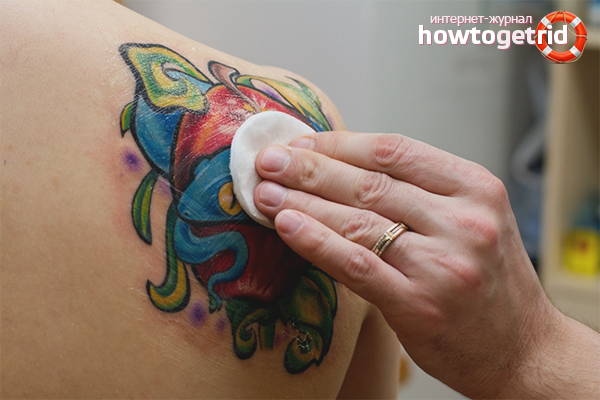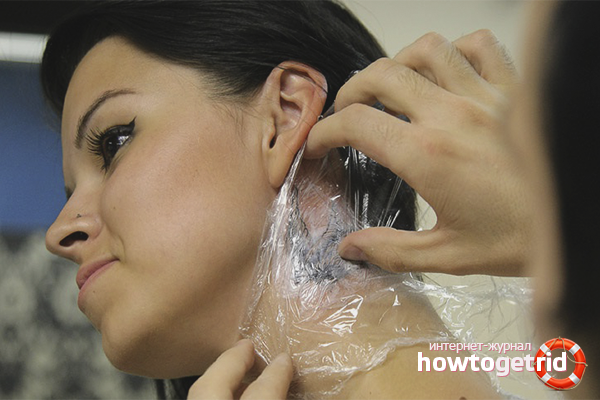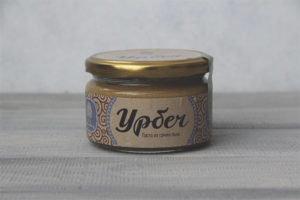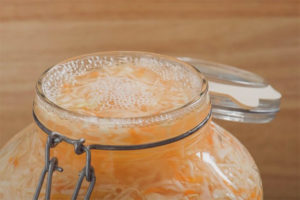The content of the article
A tattoo is a drawing on the body, applied under the skin. The coloring pigment is introduced into the subcutaneous tissue. Tattooing is a microtrauma of the skin in large areas. There are various ways of applying a body pattern, but in any case, foreign particles get into the epidermis, which leads to inflammation lasting a week. To heal faster and more painlessly, the tattoo is taken care of from the first day of application.
How skin can respond to a tattoo
Tattooing is a painful process, and healing goes the same way as restoring damaged skin. Tattoo provokes the following epidermal reactions:
- Spot hemorrhage due to damage to connective tissue and subcutaneous capillaries and blood vessels.
- Aseptic inflammation, accompanied by redness and swelling of the adjacent skin. It is caused by capillary permeability, thinning and penetration through the walls of leukocytes and red blood cells into the subcutaneous tissue. Inflammation is characterized by severe redness of the skin and even an increase in body temperature.
- Phagocytosis, a process in which macrophage cells designed to fight foreign particles (and in this case these are damaged skin cells and the pigment itself), absorb the dye itself. But macrophages cannot master the process of digestion. Due to this, the pigment remains visible under the skin.
- The body responds unpredictably to a tattoo. In the worst case, puncture sites are indicated by red pimples and a rash.
Features of tattooing
Much depends on the experience and skill of the master. However, the speed of healing is affected by the care of the pattern applied under the skin. After tattooing, this area of the skin is treated with antiseptic and healing agents. Then a kind of compress is applied from a transparent film. She performs an important task - to prevent contact of the tattoo with clothes. It will protect damaged skin from infection and accelerate healing. The master of the tattoo parlor will definitely warn you after what time the film is removed (usually 3-4 hours).
ATTENTION! You can not apply compresses to the place of tattooing yourself. Follow the recommendations given in the salon. If the situation goes out of control, consult a dermatologist. Perhaps something went wrong, and inflammation began, which turned into sepsis.
Tattooing is a traumatic process, and the body reacts to it with the formation of lymph. So, a crust forms on the skin, which subsequently falls off, which negatively affects the quality and brightness of the picture.
How to care for a tattoo in the first days after application
After removing the film, the tattoo site is washed with water and antibacterial soap. Only the following brands have proven themselves positively:
- Absolut Nature solid soap of the Russian perfume and cosmetics company Vesna. It has a pleasant aroma, does not dry the skin, cleanses well, protects against germs.
- Safeguard Antibacterial Liquid Soap. It does not spread, foams well, has a pleasant aroma of aloe vera. The component “triclocarban” fights bacteria, the antiseptic “chloroxylenol” relieves inflammation. Reliable antibacterial shield.
- Dettol Liquid Soap. Kills E. coli and Staphylococcus aureus. It has a pleasant aroma of lavender.
- Weleda Vegetable Antibacterial Soap “Tea Tree”. Disinfects the surface, helps eliminate aseptic inflammation, and promotes the healing of micro wounds.It contains only natural ingredients.
- Liquid antibacterial soap Jason. Contains panthenol and tea tree oil, chamomile extract and vitamin E. Soap will soothe inflamed skin and accelerate wound healing.
You will have to use soap often, because it is necessary to wash off the resulting crust from the lymph every 3-4 hours. Soaps are taken seriously. It needs to be tested on yourself before applying a tattoo. After all, the antibacterial effect is obtained due to the strong components to which allergies are possible.
After each washing off, a layer of Bepanten ointment or Pantenol aerosol for external use is applied to the tattooed area of the skin. The active component of dexpanthenol penetrates into the deeper layers of the skin, turning into pantothenic acid, a component of coenzyme A. Ointment or spray activates skin regeneration. They are applied in the first week 4 times a day.
Solar activity negatively affects even healthy, intact skin. What can we say about inflamed skin, on which micro wounds have not yet healed. It is forbidden to stay under the sun in the first week after applying a tattoo! If you leave the house, wear a cotton T-shirt with a long sleeve (if the tattoo is applied to the arm) or trousers made of natural fabrics. Be sure to apply sunscreen SPF = 50. It is able to protect the skin for 4 hours. This will help protect the paint from burning.
What should you limit yourself after applying a tattoo
Tattooing should be taken seriously. This is not a procedure after which you can wash your face and move on. To get a tattoo of your dreams, follow all the recommendations, as well as limit yourself to sunbathing.
- Give up fitness and sports. Not for long, just a week. During this time, the lymph will cease to excrete in large quantities, and a crust forms on the skin. If you work out in the gym or on aerobics, you can sweat and moisturize the surface of the skin with a tattoo. This will cause color distortion in the drawing.
- Stop drinking alcohol a few days before and after tattooing. Alcohol slows down the healing process of the skin.
- Do not wear artificial clothing that is tight-fitting. Any contact with irritated skin will adversely affect the healing and elimination of the effects of aseptic inflammation. If you made a tattoo in winter, wear a cotton T-shirt under a sweater or sweater.
- Before going to the tattoo parlor, please note that you should not wash for a week. Of course, no one forces you to completely abandon hygiene, but you should forget about taking a bath or even a shower for a week. If, nevertheless, water has got to the place of tattooing, be sure to blot the area, apply Bepanten or Panthenol to it and wrap it with cling film. Do not go to the swimming pool and solarium for the first 10 days, as well as the sauna and bathhouse. So you protect yourself from getting on the injured skin infection, and also remove the risk of accidentally getting a tattoo.
- If you feel bad, you have all the signs of SARS, runny nose, etc., postpone the date of the tattoo. If you have an infection or virus, healing will take several times.
Do not forget that applying a tattoo is fraught with risk, and it depends only on you how comfortable you will create the conditions for the healing process. Protect the tattoo from moisture and the sun, use quality healing products. The tattoo is applied for life, so try to bring it joy, not regret.
Video: how to care for a tattoo











Submit
If properly looked after, then no problems arise. The skin reacts normally, it may itch and itch, but against this there is a Panthenol spray that which with a smiley on the package is real. It quickly relieves itching, and thanks to it, there is no crust and the picture heals evenly. By the way, I still like him because you don’t need to smear him, which means there are no unnecessary contacts with damaged skin.
And yet, how much I read about caring for a tattoo I just can’t understand how much it needs to be covered. And is it worth it to do every time you leave home, and in general, a few hours are enough or until it heals. Everywhere information is common 🙁
Good afternoon Julia!
1) All the information on caring for a tattoo should have been told to you by the master who made it.
2) It is not worth it to constantly cover the tattoo with a film (this is done for the first time as soon as you get it done). The skin must breathe.
3) With the help of anti-inflammatory drugs (e.g. Panthenol), the healing process can be accelerated.
Julia, the master who makes a tattoo, if it’s not a dubious studio where the procedure is carried out in dubious conditions, gives a memo on how to care for a tattoo from the moment of application to the complete healing. We were constantly told about this in the courses. But about panthenol, I want to add, this is a very good means for healing. I only recommend it to my clients, but with the addition, you should use only real medical panthenol, and not a cosmetic product of the same name. The difference is simple: an orange smiley is on the medicine on the package. This is a guarantee that the drug is real and does no harm. Cosmetic ointments and creams, I do not recommend treating the tattoo, at least they can “eat” the paint, not to mention that they are not suitable for healing.